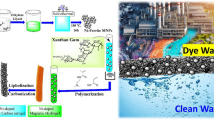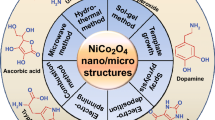Abstract
Flower-like graphene/CuO@Cu-BTC (GR/CuO@Cu-BTC) composite was employed as electrode material for the voltammetric determination of caffeic acid (CA) in the wine. The composite material was prepared via the self-template method. In this synthetic process, budlike CuO not only acts as the template, but also provides Cu2+ ions for in situ growth of the Cu-BTC shell. The utilization of GR as petal greatly boosts the stability and electronic conductivity of CuO@Cu-BTC. The GR/CuO@Cu-BTC composite possesses unique structural features with high specific surface area and good conductivity, exhibiting excellent electrocatalytic activity towards the oxidation of CA. Under optimized conditions, the sensor shows a good linear response to CA concentration over the range 0.020–10.0 μM, together with a low limit of detection (LOD) of 7.0 nM. Selectivity, reproducibility, and stability were investigated, and the method has been applied for the determination of CA in wine samples.

Schematic representation of electrochemical sensor for the detection of caffeic acid was designed based on flower-like graphene/copper oxide@copper(II) metal-organic framework (GR/CuO@Cu-BTC) composite electrode material.






Similar content being viewed by others
References
Sakthivel M, Ramaraj S, Chen SM, Dinesh B, Ramasamy HV, Lee YS (2018) Entrapment of bimetallic CoFeSe2 nanosphere on functionalized carbon nanofiber for selective and sensitive electrochemical detection of caffeic acid in wine samples. Anal Chim Acta 1006:22–32
Bianchini C, Curulli A, Pasquali M, Zane D (2014) Determination of caffeic acid in wine using PEDOT film modified electrode. Food Chem 156:81–86
Zhu G, Sun H, Zou B, Liu Z, Sun N, Yi Y, Wong KY (2018) Electrochemical sensing of 4-nitrochlorobenzene based on carbon nanohorns/graphene oxide nanohybrids. Biosens Bioelectron 106:136–141
Ponnaiah SK, Periakaruppan P (2018) A glassy carbon electrode modified with a copper tungstate and polyaniline nanocomposite for voltammetric determination of quercetin. Microchim Acta 185:524–531
Filik H, Çetintaş G, Avan AA, Aydar S, Koç SN, Boz İ (2013) Square-wave stripping voltammetric determination of caffeic acid on electrochemically reduced graphene oxide-Nafion composite film. Talanta 116:245–250
Chen TW, Rajaji U, Chen SM, Govindasamy M, Selvin SS, Manavalan S, Arumugam R (2019) Sonochemical synthesis of graphene oxide sheets supported Cu2S nanodots for high sensitive electrochemical determination of caffeic acid in red wine and soft drinks. Compos Part B Eng 158:419–427
Zhou HC, Long JR, Yaghi OM (2012) Introduction to metal-organic frameworks. Chem Rev 112:673–674
Dhaka S, Kumar R, Deep A, Kurade MB, Ji SW, Jeon BH (2019) Metal–organic frameworks (MOFs) for the removal of emerging contaminants from aquatic environments. Coord Chem Rev 380:330–352
Wang Z, Yu G, Xia J, Zhang F, Liu Q (2018) One-step synthesis of a methylene blue@ZIF-8-reduced graphene oxide nanocomposite and its application to electrochemical sensing of rutin. Microchim Acta 185:279–287
Dong Y, Duan C, Sheng Q, Zheng J (2019) Preparation of Ag@zeolitic imidazolate framework-67 at room temperature for electrochemical sensing of hydrogen peroxide. Analyst. 144:521–529
Osterrieth JW, Wright D, Noh H, Kung CW, Vulpe D, Li A, Park JE, Van Duyne RP, Moghadam PZ, Baumberg JJ, Farha OK, Fairen-Jimenez D (2019) Core-shell gold nanorod@zirconium-based metal-organic framework composites as in situ size-selective Raman probes. J Am Chem Soc 141:3893–3900
Lin L, Zhang T, Liu H, Qiu J, Zhang X (2015) In situ fabrication of a perfect Pd/ZnO@ZIF-8 core-shell microsphere as an efficient catalyst by a ZnO support-induced ZIF-8 growth strategy. Nanoscale. 7:7615–7623
Zhang CF, Qiu LG, Ke F, Zhu YJ, Yuan YP, Xu GS, Jiang X (2013) A novel magnetic recyclable photocatalyst based on a core–shell metal–organic framework Fe3O4@MIL-100(Fe) for the decolorization of methylene blue dye. J Mater Chem A 45:14329–14334
Zhang Y, Park SJ (2019) Facile construction of MoO3@ZIF-8 core-shell nanorods for efficient photoreduction of aqueous Cr (VI). Appl Catal B 240:92–101
Gu Y, Xuan Y, Zhang H, Deng X, Bai M, Wang L (2019) A facile coordination precipitation route to prepare porous CuO microspheres with excellent photo-Fenton catalytic activity and electrochemical performance. CrystEngComm. 21:648–655
Cheng S, Gao X, DelaCruz S, Chen C, Tang Z, Shi T, Carraro C, Maboudian R (2019) In situ formation of metal-organic framework derived CuO polyhedrons on carbon cloth for highly sensitive non-enzymatic glucose sensing. J Mater Chem B 7:4990–4996
Ye Q, Chen X, Yang J, Wu D, Ma J, Kong Y (2019) Fabrication of CuO nanoparticles-decorated 3D N-doped porous carbon as electrochemical sensing platform for the detection of Sudan I. Food Chem 287:375–381
Yang J, Ye H, Zhao F, Zeng B (2016) A novel CuxO nanoparticles@ZIF-8 composite derived from core-shell metal-organic frameworks for highly selective electrochemical sensing of hydrogen peroxide. ACS Appl Mater Interfaces 8:20407–20414
Hu ML, Masoomi MY, Morsali A (2019) Template strategies with MOFs. Coord Chem Rev 387:415–435
Wang F, Jia S, Li D, Yu B, Zhang L, Liu Y, Han X, Zhang R, Wu S (2016) Self-template synthesis of CuO@Cu3(BTC)2 composite and its application in cumene oxidation. Mater Lett 164:72–75
Velmurugan M, Karikalan N, Chen S, Karuppiah C (2016) Core-shell like Cu2O nanocubes enfolded with Co(OH)2 on reduced graphene oxide for the amperometric detection of caffeine. Microchim Acta 183:2713–2721
Xie Z, He Z, Feng X, Xu W, Cui X, Zhang J, Yan C, Carreon MA, Liu Z, Wang Y (2016) Hierarchical sandwich-like structure of ultrafine N-rich porous carbon nanospheres grown on graphene sheets as superior lithium-ion battery anodes. ACS Appl Mater Interfaces 8:10324–10333
Lu M, Deng Y, Luo Y, Lv J, Li T, Xu J, Chen SW, Wang J (2019) Graphene aerogel-metal-organic framework-based electrochemical method for simultaneous detection of multiple heavy-metal ions. Anal Chem 91:888–895
Zhang X, Zhang G, Wang S, Li S, Jiao S (2018) Porous CuO microsphere architectures as high-performance cathode materials for aluminum-ion batteries. J Mater Chem A 6:3084–3090
Wang Q, Yang Y, Gao F, Ni J, Zhang Y, Lin Z (2016) Graphene oxide directed one-step synthesis of flowerlike graphene@HKUST-1 for enzyme-free detection of hydrogen peroxide in biological samples. ACS Appl Mater Interfaces 8:32477–32487
Liu Y, Ghimire P, Jaroniec M (2019) Copper benzene-1,3,5-tricarboxylate (Cu-BTC) metal-organic framework (MOF) and porous carbon composites as efficient carbon dioxide adsorbents. J Colloid Interface Sci 535:122–132
Jin M, Qian X, Gao J, Chen J, Hensley DK, Ho HC, Percoco RJ, Ritzi CM, Yue Y (2019) Solvent-free synthesis of CuO/HKUST-1 composite and its photocatalytic application. Inorg Chem 58:8332–8338
Qian Y, Wang C, Gao F (2015) Ultrasensitive electrochemical detection of DNA based on Zn2+ assistant DNA recycling followed with hybridization chain reaction dual amplification. Biosens Bioelectron 63:425–431
Lamas-Ardisana PJ, Queipo P, Fanjul-Bolado P, Costa-García A (2008) Multiwalled carbon nanotube modified screen-printed electrodes for the detection of p-aminophenol: optimisation and application in alkaline phosphatase-based assays. Anal Chim Acta 615:30–38
Wang J, Zhang K, Xu H, Yan B, Gao F, Shi Y, Du Y (2018) Engineered photoelectrochemical platform for the ultrasensitive detection of caffeic acid based on flower-like MoS2 and PANI nanotubes nanohybrid. Sensors Actuators B Chem 276:322–330
Qiu X, Lu L, Leng J, Yu Y, Wang W, Jiang M, Bai L (2016) An enhanced electrochemical platform based on graphene oxide and multi-walled carbon nanotubes nanocomposite for sensitive determination of Sunset Yellow and Tartrazine. Food Chem 190:889–895
Committee AM (1987) Recommendations for the definition, estimation and use of the detection limit. Analyst 112:199–204
Liu Z, Xu J, Yue R, Yang T, Gao L (2016) Facile one-pot synthesis of Au–PEDOT/rGO nanocomposite for highly sensitive detection of caffeic acid in red wine sample. Electrochim Acta 196:1–12
Bharath G, Alhseinat E, Madhu R, Mugo S, Alwasel S, Harrath A (2018) Facile synthesis of Au@α-Fe2O3@RGO ternary nanocomposites for enhanced electrochemical sensing of caffeic acid toward biomedical applications. J Alloys Compd 750:819–827
Meshki M, Behpour M, Masoum S (2015) Application of multivariate curve resolution alternating least squares method for determination of caffeic acid in the presence of catechin interference. Anal Biochem 473:80–88
Acknowledgements
Financial support for this work was provided by the National Natural Science Foundation of China (21665010, 51862014, 31741103, 21563014, and 51302117), the outstanding youth fund of Jiangxi Province (20162BCB23027), the Natural Science Foundation of Jiangxi Province (20192BBEL50029), Provincial Projects for Postgraduate Innovation in Jiangxi (YC2019-S182), National College Students’ innovation and entrepreneurship training program (201810410013), and Natural Science Foundation of Nanchang City (No. 2018CXTD014).
Author information
Authors and Affiliations
Corresponding authors
Ethics declarations
Conflict of interest
The authors declare that they have no competing interest.
Additional information
Publisher’s note
Springer Nature remains neutral with regard to jurisdictional claims in published maps and institutional affiliations.
Electronic supplementary material
ESM 1
(DOCX 3066 kb).
Rights and permissions
About this article
Cite this article
Tu, X., Xie, Y., Gao, F. et al. Self-template synthesis of flower-like hierarchical graphene/copper oxide@copper(II) metal-organic framework composite for the voltammetric determination of caffeic acid. Microchim Acta 187, 258 (2020). https://doi.org/10.1007/s00604-020-04238-2
Received:
Accepted:
Published:
DOI: https://doi.org/10.1007/s00604-020-04238-2




